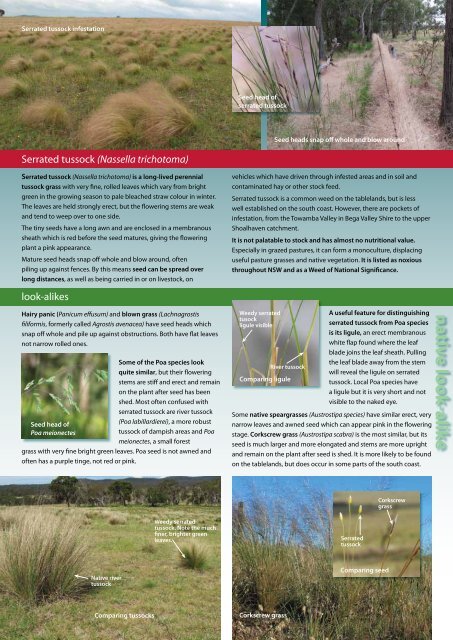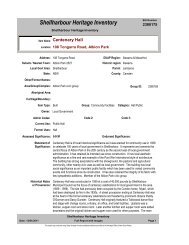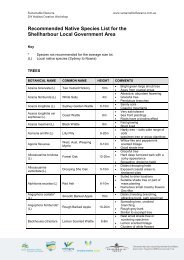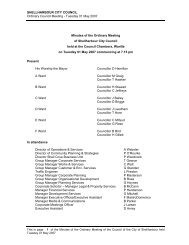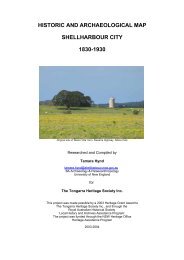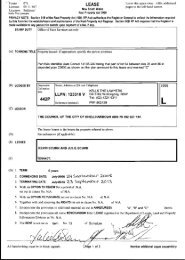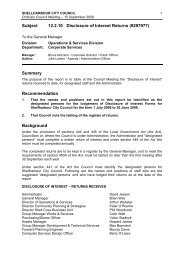WEEDY GRASSES - Shellharbour City Council
WEEDY GRASSES - Shellharbour City Council
WEEDY GRASSES - Shellharbour City Council
You also want an ePaper? Increase the reach of your titles
YUMPU automatically turns print PDFs into web optimized ePapers that Google loves.
Serrated tussock infestation<br />
Serrated tussock (Nassella trichotoma)<br />
Serrated tussock (Nassella trichotoma) is a long-lived perennial<br />
tussock grass with very fine, rolled leaves which vary from bright<br />
green in the growing season to pale bleached straw colour in winter.<br />
The leaves are held strongly erect, but the flowering stems are weak<br />
and tend to weep over to one side.<br />
The tiny seeds have a long awn and are enclosed in a membranous<br />
sheath which is red before the seed matures, giving the flowering<br />
plant a pink appearance.<br />
Mature seed heads snap off whole and blow around, often<br />
piling up against fences. By this means seed can be spread over<br />
long distances, as well as being carried in or on livestock, on<br />
look-alikes<br />
Hairy panic (Panicum effusum) and blown grass (Lachnagrostis<br />
filiformis, formerly called Agrostis avenacea) have seed heads which<br />
snap off whole and pile up against obstructions. Both have flat leaves<br />
not narrow rolled ones.<br />
Seed head of<br />
Poa meionectes<br />
Some of the Poa species look<br />
quite similar, but their flowering<br />
stems are stiff and erect and remain<br />
on the plant after seed has been<br />
shed. Most often confused with<br />
serrated tussock are river tussock<br />
(Poa labillardierei), a more robust<br />
tussock of dampish areas and Poa<br />
meionectes, a small forest<br />
grass with very fine bright green leaves. Poa seed is not awned and<br />
often has a purple tinge, not red or pink.<br />
Native river<br />
tussock<br />
Comparing tussocks<br />
Weedy serrated<br />
tussock. Note the much<br />
finer, brighter green<br />
leaves.<br />
Seed head of<br />
serrated tussock<br />
vehicles which have driven through infested areas and in soil and<br />
contaminated hay or other stock feed.<br />
Serrated tussock is a common weed on the tablelands, but is less<br />
well established on the south coast. However, there are pockets of<br />
infestation, from the Towamba Valley in Bega Valley Shire to the upper<br />
Shoalhaven catchment.<br />
It is not palatable to stock and has almost no nutritional value.<br />
Especially in grazed pastures, it can form a monoculture, displacing<br />
useful pasture grasses and native vegetation. It is listed as noxious<br />
throughout NSW and as a Weed of National Significance.<br />
Weedy serrated<br />
tusock<br />
ligule visible<br />
A useful feature for distinguishing<br />
serrated tussock from Poa species<br />
is its ligule, an erect membranous<br />
white flap found where the leaf<br />
blade joins the leaf sheath. Pulling<br />
the leaf blade away from the stem<br />
will reveal the ligule on serrated<br />
tussock. Local Poa species have<br />
a ligule but it is very short and not<br />
visible to the naked eye.<br />
Some native speargrasses (Austrostipa species) have similar erect, very<br />
narrow leaves and awned seed which can appear pink in the flowering<br />
stage. Corkscrew grass (Austrostipa scabra) is the most similar, but its<br />
seed is much larger and more elongated and stems are more upright<br />
and remain on the plant after seed is shed. It is more likely to be found<br />
on the tablelands, but does occur in some parts of the south coast.<br />
Corkscrew grass<br />
Seed heads snap off whole and blow around<br />
River tussock<br />
Comparing ligule<br />
Serrated<br />
tussock<br />
Comparing seed<br />
Corkscrew<br />
grass


